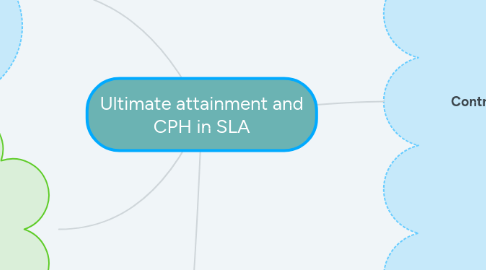
1. Preliminaries
1.1. Age effects
1.2. Long(1990)
1.2.1. Native-like abilities
1.2.1.1. Phonological
1.2.1.1.1. begins at 6
1.2.1.1.2. declines at 12
1.2.1.2. Morphology and Syntax
1.2.1.2.1. before 15
1.2.2. Decline in abilities is the result of incremental losses of natural plasticity due to brain maturation
1.3. Time-boundedness in SLA
1.3.1. existence of discontinuity in the slope of the decline around the terminus
1.3.2. absence of native-like acquisition in late learners
2. Discontinuity or linearity
2.1. AoA
2.1.1. Patkowski(1980)
2.1.1.1. discontinuity of pronunciation by 15
2.1.1.2. similar with Long
2.1.2. Harley and Wang (1997)
2.2. of pronunciation is not only before AoA but also long after the terminus of the critical period
3. Post-critical period's effect on native-likeness
3.1. Different surveys different results
3.1.1. By Long was put at 12
3.1.2. Birdsong (2004)
3.1.2.1. morphosyntax domain seems to be higher
3.2. Marinova-Todd (2003)
3.2.1. no one obtained native-like scores on all tasks
3.2.2. 3 of 9 tasks
3.2.3. some late learners performed at a native level on some tasks
3.3. Late learners can obtain native-like performance
3.3.1. in a variety of linguistic domains
3.3.2. if the L2 is closely related to the NL
3.4. AoA is one but not the most important
4. Contributions to the real issues
4.1. 5 contributions
4.1.1. Singleton
4.1.1.1. Language learning capacities
4.1.1.1.1. Maturational constrains
4.1.2. Long
4.1.2.1. only young child starters can (not necessarily will) attain native-like proficiency level
4.1.2.2. 9 problems
4.1.2.2.1. confusion of rate and ultimate attainment
4.1.2.2.2. inappropriate choice of subjects
4.1.2.2.3. measurement of AoA
4.1.2.2.4. Leading instructions to raters
4.1.2.2.5. assessment based on limited samples
4.1.2.2.6. using non-native samples to make near-native samples
4.1.2.2.7. unreliable or invalid measures
4.1.2.2.8. inappropriate L1 and L2 pairings
4.1.2.2.9. faulty interpretation of statistical patterns
4.1.3. Birdsong
4.1.3.1. native-likeness and non-native-likeness
4.1.3.2. nook and cranny of the target language speakers
4.1.3.3. studies effects of L2 on L1
4.1.3.3.1. and Effects of L1 on L2 of bilinguals
4.1.3.4. effects of bilingualism
4.1.3.4.1. cognitive costs of maintaining L1
4.1.3.5. it is impossible with tasks involving language processing if the L1 is maintaining
4.1.4. Child/adult differences
4.1.4.1. Stowe and Sabourine
